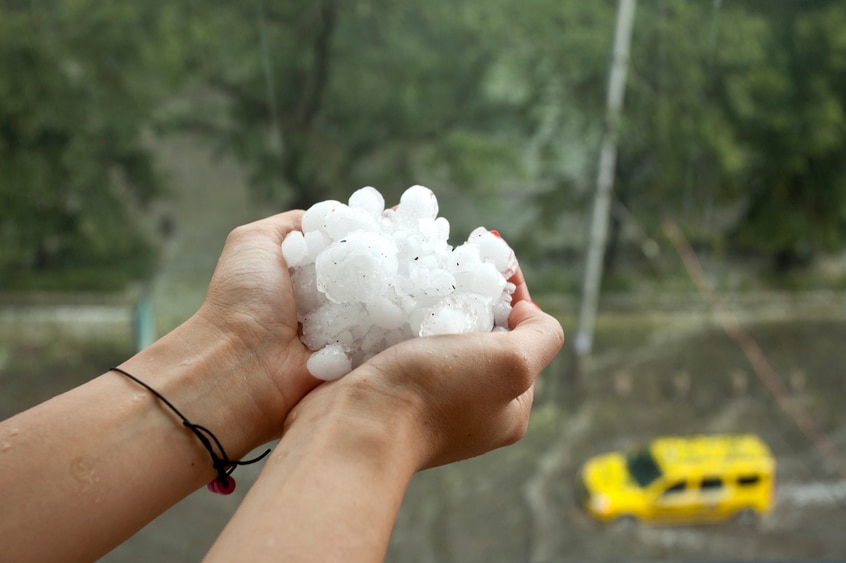Hail damage occurs in many U.S. regions and is most common during summer months, which might strike you as strange (no pun intended). The reasons why hail is common in the summer and why it looks the way it does is interesting:
- In the summer, there is a lot more energy in the atmosphere, which means clouds get bigger and denser.
- Within the largest clouds, cumulonimbus, strong updrafts lift water droplets high into the colder parts of the cloud where they freeze.
- Those ice balls fall and then rise again — each time adding a new layer of ice. Eventually, they get too heavy for the updrafts to support and they fall to the ground.
- Sometimes there are so many small ice balls falling and rising within a cloud that they collide and stick together.
- When you see lumpy, misshapen hail, it's because many smaller ice balls stuck together. Also, if you cut into a hailstone, you will see the rings indicating how many times that ice ball fell and rose within the cloud.
- Hailstones can measure between 0.2 and 6 inches. The largest ones can fall as fast as 100 mph and cause significant damage.
The National Oceanic and Atmospheric Administration, NOAA, estimates that 97% of hail is '⧠2 inches in diameter. They report that 10 states make up 54% of the hail that's larger than 2 inches, and have published the map shown here: 
Damage to property includes siding and roofing, but because hail is so variable, it has not been possible to predict a product's hail resistance. At GAF, we rate the ice-ball impact resistance of single-ply systems using an ice-ball launcher that we developed.
Ice-ball launcher — 2-inch diameter ice balls are propelled downward onto a 12 x 12 inch deck
The ice balls are fired at a 12" x 12" simulated roof deck — which normally consists of a membrane, cover board, if used, and 2-inch polyiso, all above a ¬Ω-inch plywood board. Two shots are made onto the same point and then the deck is evaluated. After we conducted this test, we found some very clear initial conclusions:
- Direct hits above a fastener always punctured the membrane. This was the case for both membrane and insulation fasteners.
- Hits on the field of the membrane, over regular polyiso insulation resulted in dimpling of the sheet. However, the membrane wasn't punctured.
Ice-ball impact above fasteners always punctures the membrane. Left to right: increasing damage from hairline crack to complete puncture.
The dimpling of the membrane above polyiso had us wondering about damage to the membrane substrate after ice-ball impact. After two impacts on the field of TPO, here's what happened to the layer underneath:
- Polyiso without Cover Board — the polyiso paper facer split and the foam was crushed to a depth of about ¬Ω-inch.
- Gypsum Board — the core of the board was reduced to powder. The facer on the underside of the board cracked.
- HD Polyiso — the core of the board showed some cracking and facer delamination.
So, we moved on to perhaps the best question — can a system be constructed to avoid suffering from ice-ball impact damage? After looking at combinations of coverboard, adhesives, and fleeceback versus smooth membrane, we made the following general observations:
- Membrane thickness: Data for the fully adhered systems support the argument that a thicker membrane is better.
- Fleece backing: The presence of fleece noticeably helped reduce damage to the cover boards. In addition, heavier-weight fleece gave the most protection to any cover board.
- Adhesive type: No differences were seen between water and solvent-based adhesives. However, low-rise foam appeared to absorb impact energies sufficiently so much that the cover board cores were not damaged.
- Cover board type: It was apparent the gypsum cover board sustained significant damage to the board after impact. The HD polyiso board showed damage in certain cases, but not all. In particular, the heavier fleece, thicker membrane, or the use of low-rise foam, singly or in combination, gave no damage to the HD board core.
At the end of the study, it appeared the following systems minimized ice-ball impact damage:
- 60 mil fleece-back membrane and 2-part foam adhesive over adhered polyiso cover board.
- 80 mil fleece-back membrane with any adhesive type over adhered polyiso cover board.
So, back to the opening description of actual hail, it's clear that predicting hail resistance isn't yet possible. However, this study can act as a guide for ranking the various membranes and systems. Read more about the ice ball impact tests in the June 2016 issue of Professional Roofing.



